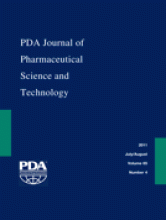Abstract
The pharmaceutical and biotechnology industries have long been challenged with setting appropriate cosmetic defect size acceptance criteria on glass vials. Limits are rarely data-driven and scarce information is available on defect survivability through shipping and handling downstream of final product visual inspection. This study was undertaken to quantitatively understand cosmetic defect dynamics on glass vials and their impact on patient safety.
Scratch and bruise defects were artificially manufactured on product or placebo-filled, inspected, and glass defect–free tubing vials. The vials were processed and filled using commercial filling operations (i.e., vial washing, heat tunnel, conveyors, lyophilization, etc.). The defects were quantitatively characterized, subjected to automated packaging simulations, manually packaged in the approved commercial configurations, and subjected to ASTM Level I (highest intensity) shipping simulations in both pallet and small package configurations. The defects showed no statistically significant or applicable level of propagation, post-packaging and shipping simulation. Additionally, all test vials were subjected to dye leak testing, post-shipping simulation. All vials, except for one, met acceptance criteria for dye leak testing. Data-driven cosmetic defect dimensions for scratches and bruises were established based on this study.
LAY ABSTRACT: When delivering life saving medicines from the manufacturing plant to the patient, it is of great importance that the medicines arrive without damage that might harm the patient. In the case of medicines filled into glass vials, it is paramount that manufacturers understand whether minor cosmetic defects in the glass (such as small scratches and bruises) may weaken the vial enough to cause damage that might allow contamination of the contents.
This study was performed to determine if scratches and bruises on the glass vials might propagate during operations that occur downstream of the manufacturer's final vial inspection. The study vials were filled with product or placebo on the commercial filling lines to fully simulate environmental factors in a typical run. Scratches and bruises were then artificially created on the vials. Each defect was measured microscopically and labeled. The study population was then manually packaged into the approved configurations and subjected to the highest level intensity shipping simulations (ASTM Level 1).
Upon completion of the simulations, the vials were unpackaged and defects re-measured microscopically. The defects showed no statistically significant or applicable level of propagation. Additionally, all test vials were subjected to dye leak testing, post-shipping simulation. All vials, except for one, met acceptance criteria. Data-driven cosmetic defect dimensions for scratches and bruises were established based on this study.
- Andersen-Darling test
- ASTM
- ASTM D4169-08
- ASTM D7386-08
- Cosmetic defects
- Defect propagation
- Dunnage
- Dye leak testing
- Glass defects
- Heel sticker
- Mann-Whitney test
- Packaging simulation
- Paired T-test
- Pallet
- Power values
- Shipper
- Shipping simulation
- Small parcel
- Tubing glass vials
- Vial scratch
- Vial bruise
- Visual inspection
- White light interferometry
- © PDA, Inc. 2011
PDA members receive access to all articles published in the current year and previous volume year. Institutional subscribers received access to all content. Log in below to receive access to this article if you are either of these.
If you are neither or you are a PDA member trying to access an article outside of your membership license, then you must purchase access to this article (below). If you do not have a username or password for JPST, you will be required to create an account prior to purchasing.
Full issue PDFs are for PDA members only.
Note to pda.org users
The PDA and PDA bookstore websites (www.pda.org and www.pda.org/bookstore) are separate websites from the PDA JPST website. When you first join PDA, your initial UserID and Password are sent to HighWirePress to create your PDA JPST account. Subsequent UserrID and Password changes required at the PDA websites will not pass on to PDA JPST and vice versa. If you forget your PDA JPST UserID and/or Password, you can request help to retrieve UserID and reset Password below.






